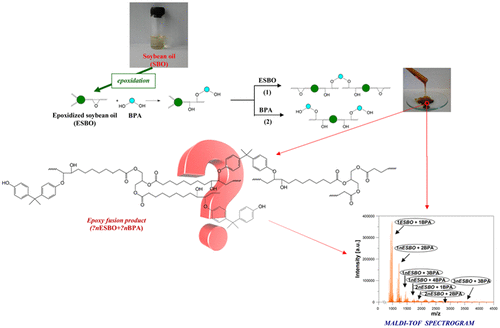当前位置:
X-MOL 学术
›
ACS Sustain. Chem. Eng.
›
论文详情
Our official English website, www.x-mol.net, welcomes your feedback! (Note: you will need to create a separate account there.)
Synthesis of High-Molecular Weight Biobased Epoxy Resins: Determination of the Course of the Process by MALDI-TOF Mass Spectrometry
ACS Sustainable Chemistry & Engineering ( IF 8.4 ) Pub Date : 2018-04-05 00:00:00 , DOI: 10.1021/acssuschemeng.7b04727 Anna Sienkiewicz 1 , Piotr Czub 1
ACS Sustainable Chemistry & Engineering ( IF 8.4 ) Pub Date : 2018-04-05 00:00:00 , DOI: 10.1021/acssuschemeng.7b04727 Anna Sienkiewicz 1 , Piotr Czub 1
Affiliation

|
The presented research shows the results of matrix-assisted laser desorption/ionization mass spectrometry, which was used as a means of monitoring the synthesis of novel high-molecular weight epoxy resins. The products were obtained by the reaction of epoxidized soybean oil (ESBO) and bisphenol A (BPA), using a modern and pro-ecological modification of the well-known method of the synthesis of epoxy resins, called “the epoxy fusion process”. On the basis of the obtained spectrograms, the manner in which substrates reacted with each other during the conducted synthesis was determined. Initially, after the reaction of the oxirane group of ESBO with the hydroxyl group of BPA, subsequent reactions occurred, involving other molecules of bisphenol and the remaining oxirane rings of epoxidized vegetable oil or the reaction of a free phenolic group with the following macromolecule of modified oil. It was found that the final product of the polyaddition (ESBO_BPA), obtained by the epoxy fusion process conducted in bulk, consists of macromolecules with various structure. First, smaller oligomers such as 1ESBO + 1BPA and ESBO + 2BPA were formed, and as the reaction proceeded, they rapidly reacted with each other forming larger macromolecules: 2ESBO + 2BPA, ESBO + 3BPA, 2ESBO + 3BPA, 3ESBO + 3BPA, and 3ESBO + 4BPA. On the basis of the course of the ESBO_BPA polyaddition process in the registered m/z range, it was found that 1ESBO + 1BPA tends to react with other substrates from the reacting mixture to create a linear product. Bisphenol A is a rigid element, which connects the elastic alkyl chains of epoxidized soybean oil in the obtained macromolecule.
中文翻译:

高分子量生物基环氧树脂的合成:通过MALDI-TOF质谱法确定工艺过程
提出的研究显示了基质辅助激光解吸/电离质谱的结果,该方法被用作监测新型高分子量环氧树脂合成的手段。这些产物是通过环氧化大豆油(ESBO)与双酚A(BPA)的反应获得的,使用对环氧树脂合成的众所周知的方法进行了现代的,生态学上的改进,称为“环氧熔融工艺”。基于获得的光谱图,确定在进行的合成期间底物彼此反应的方式。最初,ESBO的环氧乙烷基与BPA的羟基发生反应后,随后发生了反应,涉及其他双酚分子和环氧化植物油的其余环氧乙烷环或游离酚基与以下改性油大分子的反应。发现通过本体进行的环氧熔融方法获得的加成产物的最终产物(ESBO_BPA)由具有各种结构的大分子组成。首先,形成较小的低聚物,例如1ESBO + 1BPA和ESBO + 2BPA,随着反应的进行,它们彼此迅速反应形成较大的大分子:2ESBO + 2BPA,ESBO + 3BPA,2ESBO + 3BPA,3ESBO + 3BPA和3ESBO + 4BPA。根据ESBO_BPA加法过程的过程在注册 通过散装进行的环氧熔融工艺获得的大分子由具有各种结构的大分子组成。首先,形成较小的低聚物,例如1ESBO + 1BPA和ESBO + 2BPA,随着反应的进行,它们彼此迅速反应形成较大的大分子:2ESBO + 2BPA,ESBO + 3BPA,2ESBO + 3BPA,3ESBO + 3BPA和3ESBO + 4BPA。根据ESBO_BPA加法过程的过程在注册 通过散装进行的环氧熔融工艺获得的大分子由具有各种结构的大分子组成。首先,形成较小的低聚物,例如1ESBO + 1BPA和ESBO + 2BPA,随着反应的进行,它们彼此迅速反应形成较大的大分子:2ESBO + 2BPA,ESBO + 3BPA,2ESBO + 3BPA,3ESBO + 3BPA和3ESBO + 4BPA。根据ESBO_BPA加法过程的过程在注册在m / z范围内,发现1ESBO + 1BPA倾向于与反应混合物中的其他底物反应以生成线性产物。双酚A是刚性元素,其连接所获得的大分子中的环氧化大豆油的弹性烷基链。
更新日期:2018-04-05
中文翻译:

高分子量生物基环氧树脂的合成:通过MALDI-TOF质谱法确定工艺过程
提出的研究显示了基质辅助激光解吸/电离质谱的结果,该方法被用作监测新型高分子量环氧树脂合成的手段。这些产物是通过环氧化大豆油(ESBO)与双酚A(BPA)的反应获得的,使用对环氧树脂合成的众所周知的方法进行了现代的,生态学上的改进,称为“环氧熔融工艺”。基于获得的光谱图,确定在进行的合成期间底物彼此反应的方式。最初,ESBO的环氧乙烷基与BPA的羟基发生反应后,随后发生了反应,涉及其他双酚分子和环氧化植物油的其余环氧乙烷环或游离酚基与以下改性油大分子的反应。发现通过本体进行的环氧熔融方法获得的加成产物的最终产物(ESBO_BPA)由具有各种结构的大分子组成。首先,形成较小的低聚物,例如1ESBO + 1BPA和ESBO + 2BPA,随着反应的进行,它们彼此迅速反应形成较大的大分子:2ESBO + 2BPA,ESBO + 3BPA,2ESBO + 3BPA,3ESBO + 3BPA和3ESBO + 4BPA。根据ESBO_BPA加法过程的过程在注册 通过散装进行的环氧熔融工艺获得的大分子由具有各种结构的大分子组成。首先,形成较小的低聚物,例如1ESBO + 1BPA和ESBO + 2BPA,随着反应的进行,它们彼此迅速反应形成较大的大分子:2ESBO + 2BPA,ESBO + 3BPA,2ESBO + 3BPA,3ESBO + 3BPA和3ESBO + 4BPA。根据ESBO_BPA加法过程的过程在注册 通过散装进行的环氧熔融工艺获得的大分子由具有各种结构的大分子组成。首先,形成较小的低聚物,例如1ESBO + 1BPA和ESBO + 2BPA,随着反应的进行,它们彼此迅速反应形成较大的大分子:2ESBO + 2BPA,ESBO + 3BPA,2ESBO + 3BPA,3ESBO + 3BPA和3ESBO + 4BPA。根据ESBO_BPA加法过程的过程在注册在m / z范围内,发现1ESBO + 1BPA倾向于与反应混合物中的其他底物反应以生成线性产物。双酚A是刚性元素,其连接所获得的大分子中的环氧化大豆油的弹性烷基链。



























 京公网安备 11010802027423号
京公网安备 11010802027423号